Just as ‘sugar disease’ causes fatigue in the body, wrong government policies and the attitude of the industrialists towards growers have fatigued sugarcane farmers. Field reporting from Madhes and Lumbini.
Praju Pant |CIJ, Nepal
Sonudevi Yadav, with her grey hair covered with the loose end of her yellow saree, was found near the tomb of her husband Narayan Ray Yadav, whose final resting place lies near the Pranami temple in Dhankaul-7, Sarlahi. “My man is buried in this soil, so I am also here,” she said. “I told him not to go to Kathmandu during the cold, but he wouldn’t heed my advice. He passed away when he was there.”
Narayan had gone to Kathmandu with other agitating farmers after the sugar mills didn’t pay them for their sugarcane crop. His body couldn’t bear the chill of Kathmandu in December. According to Narayan’s eldest son Siyaram, the Yadav family has been cultivating sugarcane since 1992. The family has been cultivating sugarcane on 67 acres of land. However, Annapurna Sugar Mill, which bought the family’s produce, didn’t pay Rs 2.4 million for the purchase. Siyaram says the family owes a local lender Rs 2.8 million, for a loan it took to cultivate the crop.
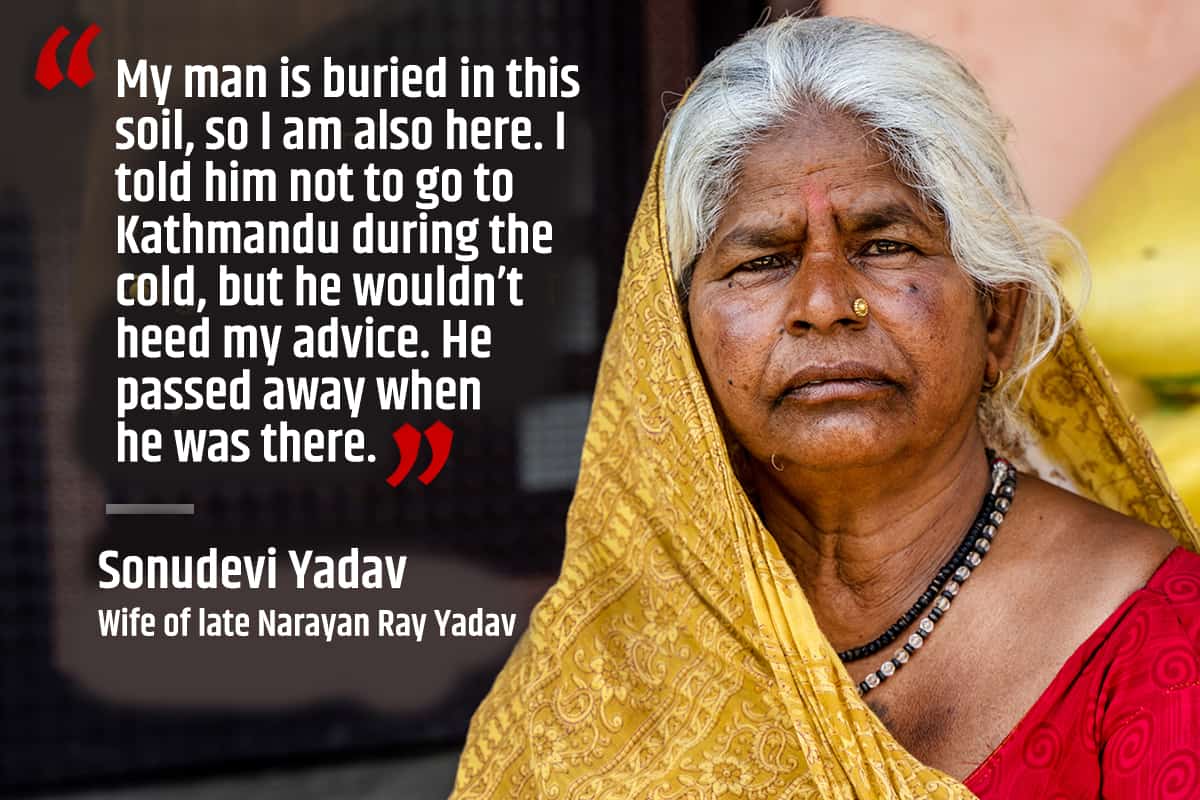
“The debt took away our father from us. Now it has made life difficult for us,” says Siyaram. “If the sugar mill had paid us on time, our father would have lived longer. He died of a heart attack at the age of 65.”
According to Siyaram, the government provided the family Rs 25,000 on December 29, 2020 as relief after his father and other farmers organised rallies in Kathmandu. Although the government said it would provide Rs 1 million to each family, it is yet to do so.
Within four days of Narayan’s death, Annapurna Sugar Mills paid Rs 2.15 million of the outstanding amount to his family. However, Siyaram said that the amount was only enough to pay interest on a loan taken earlier.
Siyaram, who now grows sugarcane on only 33 acres of land, sold his harvest at Rs 3,590 per quintal this time. Even though he received cash, the interest accrued on the loan is making it difficult for the family.
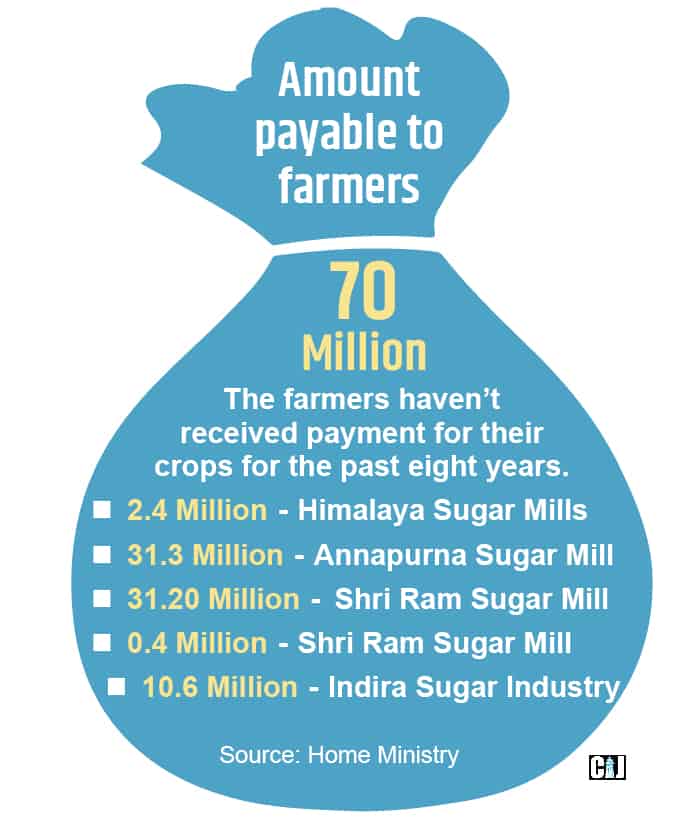
Jukti Ray Yadav of Dhankaul has also not received Rs 26,900 for the sugarcane he sold in 2018. He says, “After the agitation in Kathmandu, the government had promised to release the pending amount immediately, but it hasn’t done so yet.”
Mukesh Thakur of Godaita, Sarlahi is yet to receive Rs 100,000 from Annapurna Sugar Mill. “After going to Kathmandu twice during the agitation, I got the money from the sale of sugarcane, but the mill didn’t pay me the government grant relief money,” says Thakur. He grows sugarcane on 8 acres of land and is burdened with debt.
Gyan Prasad Bhattarai, manager of Annapurna Sugar Mill, says his office is processing all pending payments. “We are gradually paying the pending amount. We are paying the farmers even when we as a company are in debt. ”
Rs 70 million in payments pending
The farmers haven’t received payment for their crops for the past eight years.
Sugar mills that don’t pay on time, a government that can’t even recommend improved varieties of seeds and farmers growing crops by taking loans paint a clear picture of an ‘agrarian’ country.
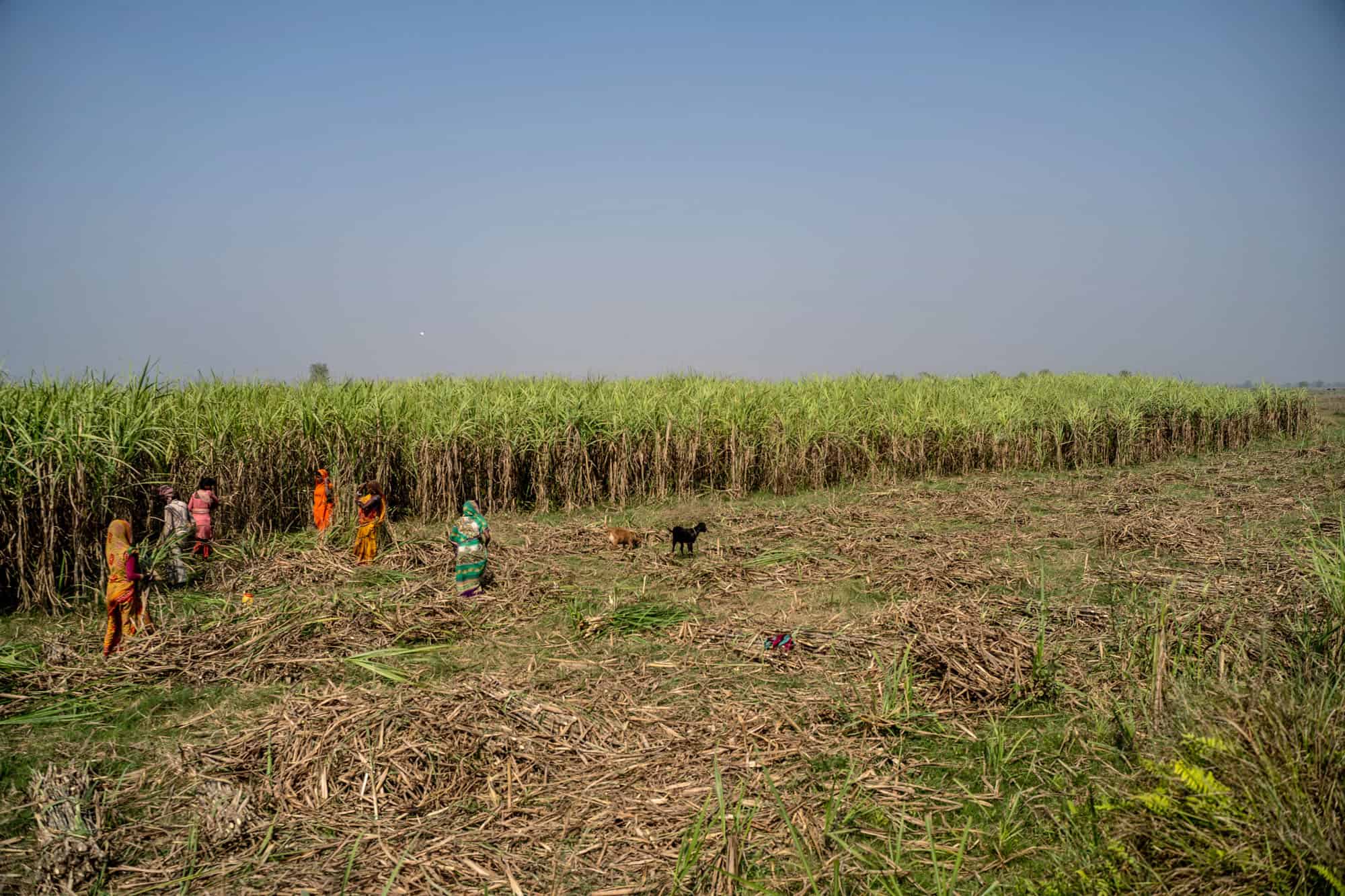
Sugarcane plantation of Narayan Ray Yadav in Dhankaul, Sarlahi.
According to the Ministry of Home Affairs, as of December last year, sugar mills are yet to pay farmers Rs 76 million for their produce.
Himalaya Sugar Mills owes farmers Rs 2.4 million, Annapurna Sugar Mill Rs 31.3 million and Shri Ram Sugar Mill Rs 31.20 million. Similarly, Lumbini Sugar Industry owes farmers Rs 400,000 and Indira Sugar Industry Rs 10.6 million
Basanta Bhattarai, information officer at the Ministry of Home Affairs, says that the Ministry of Industry has helped farmers by taking up their issues with the mills through the district administration offices. “A total of Rs 696 million was disbursed to the farmers with help from the administration. More payments are being processed,” he says.
The ministry does not have data on the number of unpaid farmers. Anup Chaudhary, president of the Kapilvastu Farmers’ Association, says that the number of unpaid farmers is around 8,000.
Home Ministry Information Officer Bhattarai says,” We are raising money from the mills in instalments and depositing it in the farmer’s account. We hope all the pending dues will be cleared by the end of the next fiscal year.”
Mills pocket government relief money
The problem was exacerbated after the government provided relief to the farmers through the mills. According to Chaudhary, some of the mills haven’t disbursed the relief amount sent by the government. Although there is no problem in payments now, the problem had arisen after the mills allegedly pocketed the old arrears and the relief amount sent to the farmers by the government.
Considering the dispute between the farmers and the industry over the price of sugarcane every year, the government decided to set a minimum price every year after discussions between the Ministry of Agriculture, Ministry of Industry, Commerce and Supply, industrialists and farmers.

Until three years ago, the government used to refund 70 percent of the value added tax (VAT) on the sale of sugar to promote the domestic sugar industry. In the Fiscal Year 2014/15, the government decided to provide Rs 25 per quintal as subsidy to the farmers for the promotion of sugarcane farming.
At that time, it was said that such a subsidy would be provided only for 23 million quintals of sugarcane. According to the Ministry of Agriculture and Livestock Development, 43.46 million quintals of sugarcane was produced that year.
In 2014/15, when the price of sugarcane was fixed at Rs 431 per quintal, the mills pressed the government to cut prices as imported sugar would be cheaper compared to the domestic produce. According to Gyan Prasad Bhattarai, a former member of the Sugar Industries Association, 500,000 metric tonnes of sugar had to be stored in warehouses at that time. “As imports from Pakistan, India and Brazil increased, the government increased customs on imported sugar to protect domestic industries. But it took three years for the stock to be sold as the market was flooded with imports,” says Bhattarai.
Kapil Muni Mainali, president of the Federation of Sugarcane Growers Nepal, says that the traders importing large quantities of sugar influence the government policies at the cost of farmers. “Not only in 2015, but also in the following years, the government has made the farmers miserable by importing more sugar,” he says.
Meanwhile, sugar mills that incurred losses, became reluctant to pay the farmers for the purchase of sugarcane. The demand of the industrialists was to abolish the fixed price regime for sugarcane and to set up a mechanism to distribute the government budget set aside for sugarcane promotion.
Amid all this, the government decided to release a tranche of relief for farmers who hadn’t been paid by the mills. The government disbursed Rs. 457.5 million on February 18, 2016 and later Rs 63 million. The amount was sent to the mills through the concerned District Agriculture Development Office.
The ministry insists that the money had to be sent through the mills as the government doesn’t have the data on the farmers. Although some mills deposited the grant money in the farmers’ accounts, Mahalakshmi Sugar Mill and Mahakali Sugar didn’t.
After being repeatedly called out by the farmers of Kanchanpur, Mahakali Sugar Mill submitted the data of the sugarcane and the farmers to the government and deposited the grant amount to the farmer’s account. But Mahalakshmi Sugar Mill didn’t provide the details. Even though Mahalakshmi sent the details on March 23, 2018, by that time the Ministry of Finance had adjusted the amount to the value added tax refund received by the industrialists so that the farmers could get reimbursement from the mill. But that hasn’t been done yet.
Anup Chaudhary, president of the Kapilvastu Farmers’ Association, said, “That amount has been adjusted to the value added tax received by the industrialists. But mill director Kanodia hasn’t paid us.”
Anup Chaudhary of Kapilvastu Farmers’ Association says that Mahalakshmi Sugar Mill hasn’t disbursed the grant even though other mills have done so.
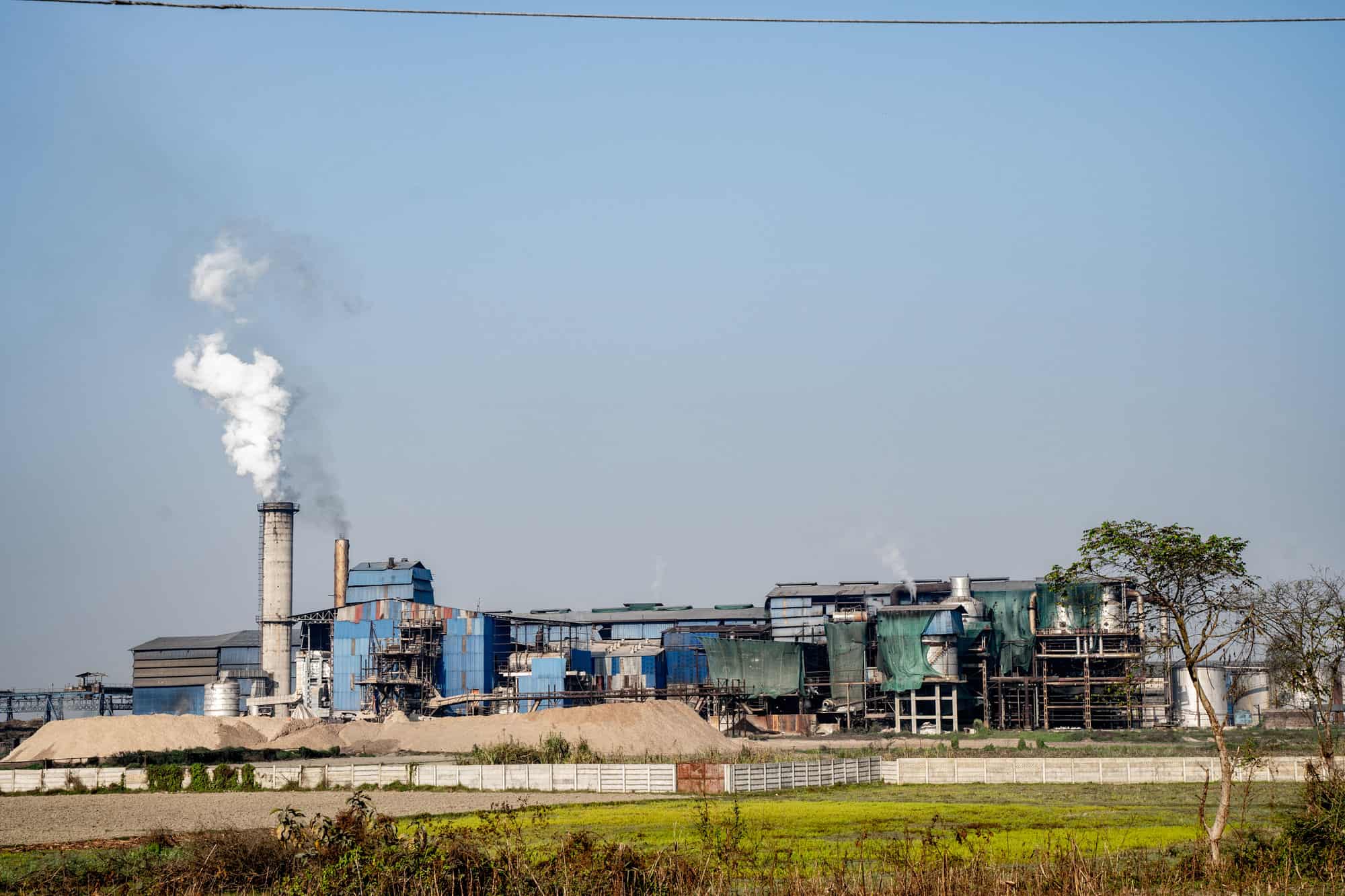
Reliance Sugar Mill, Bara.
Chaudhary claims that farmers have been cheated not only in the grant amount but also in various ways since 2014/15. He says, “ In 2014/15, the government had fixed the price of sugarcane at Rs. 461 per quintal, but the operator of Mahalakshmi Sugar Mill Virendra Kanodia, gave only Rs 392. The next year, Rs 448 was fixed but only Rs. 441 was given. In 2016, the government rate was fixed at Rs 531 per quintal, but only Rs 492 was given. The government grant was not given to us by the Ministry of Finance by adjusting it with the VAT refund. The mill was relocated to Sarlahi three years ago.”
Director of Mahalakshmi Sugar Mill Birendra Kanodia says his company doesn’t owe the farmers any money. “I don’t have to pay any amount to the farmer, ” he says. I have not embezzled the grant amount. ”
Farmers don’t agree with Kanodia’s claim. They allege that Kanodia’s mill even cheated them by tampering with the weight.
Ramswarth Ray Yadav, chairman of the Sugarcane Farmers’ Struggle Committee, alleges that the Mahalakshmi Sugar Mill has tampered with the weight and paid less even when farmers were made to sign invoices as per the price fixed by the government.
Yadav says, “Illiterate farmers have been deceived as the price they get was different from what was written in the bill. The government didn’t pay attention to this.”
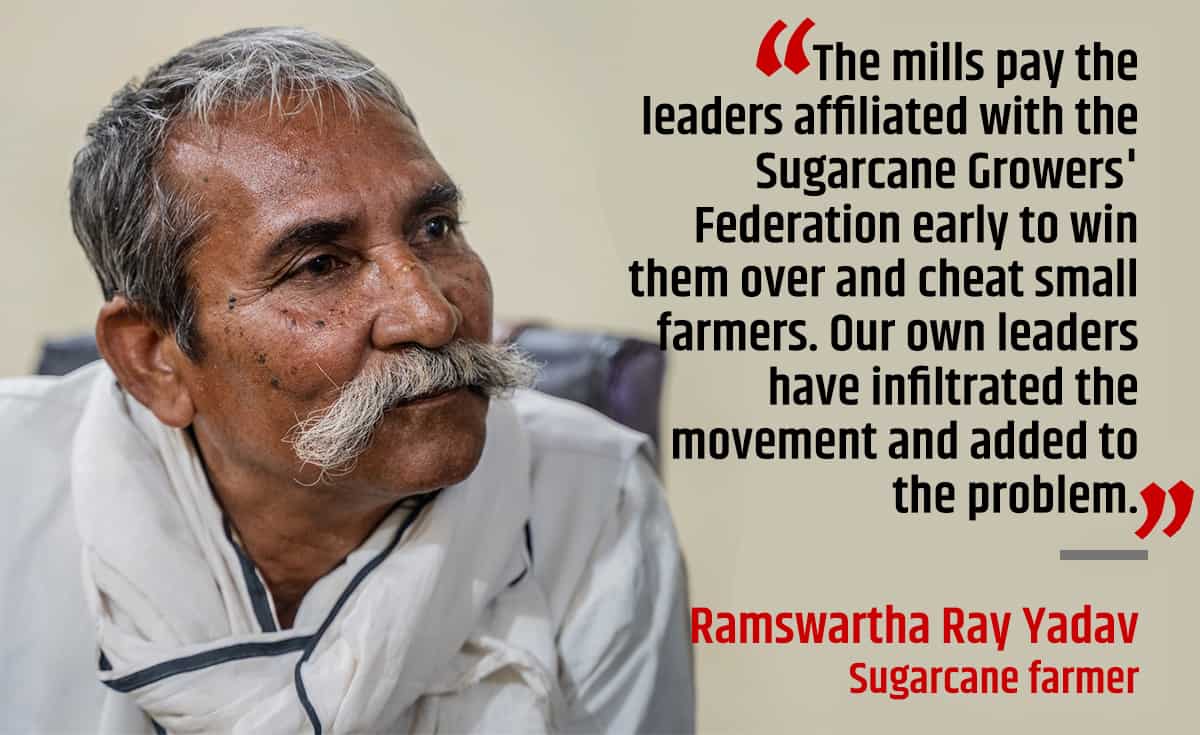
The government said that the Lumbini Sugar Mill has erred in weighing sugarcane, but hasn’t said anything about other mills. In the complaint filed by the farmers at the Commission for Investigation of Abuse of Authority on March 4, 2022, it is mentioned that the mill was dishonest while weighing sugarcane.
The mills can deduct the weight of cane leaves and tied straw by one percent of the total weight and the weight of cane grown from last year’s stump by up to 5 percent. But the farmers allege that the mill deducted the weight of new sugarcane by 5 percent to 20 percent.
According to Urmila KC Kisan, under secretary at the Ministry of Industry, Commerce and Supplies, the amount the mills owe to the farmers has been calculated on the basis of the invoices presented. “The unpaid amount has been calculated on the basis of the invoices received from farmers. We can only acknowledge payment for which we have evidence. ”
Devendra Yadav, central member of the Federation of Sugarcane Growers and the then mayor of Godaita Municipality, Sarlahi, said that the mill was yet to pay some amount to the sugarcane farmers and that it would be received through the district administration office soon.
According to him, ‘variety 150’ of sugarcane was procured by the mills at lower prices. Yadav says, “Since ‘variety 150’ produces less juice compared to other varieties, Mahalakshmi Mill bought it at a price lower than the price fixed by the government. Apart from Annapurna, other mills have already paid all their dues to the farmers.”
Farmer Ramswarth Rai Yadav says that Mahalakshmi not only paid less for ‘variety 150’, sugarcane but for other varieties of sugarcane. “The mills pay the leaders affiliated with the Sugarcane Growers’ Federation early to win them over and cheat small farmers,” he said. “Our own leaders have infiltrated the movement and added to the problem.”
Expensive sugar hits consumers
The government created problems by imposing low customs on sugar imports and transferring the amount of subsidy meant for farmers to the accounts of the mills. On top of that, the farmers were further affected when the industrialists did not buy sugarcane at the price fixed by the government.
In 2016, the then Council of Ministers had fixed the customs duty rate on sugar import at 15 percent. The Sugar Industry Association objected to this stating domestic sugar industries couldn’t compete with imported sugar when the customs duty was set so low. At that time, the customs duty on sugar in other South Asian countries was 100 percent.
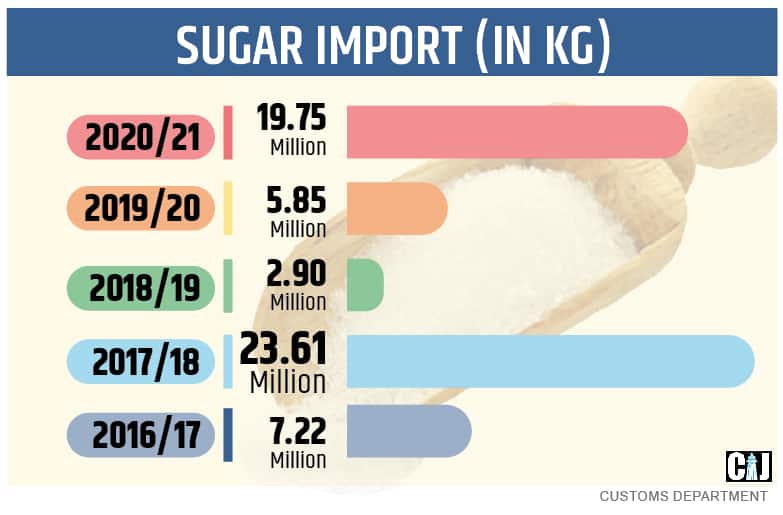
After constant pressure from industrialists, the government imposed a 30 percent customs duty on sugar imports on May 1, 2018. At present, the tariff rate stands at 40 percent. Despite the government’s efforts to promote domestic industries, consumers are forced to buy sugar at higher prices due to a decline in production.
At present, the price of sugar in the bordering Indian market is Rs. 70 per kg while in the Nepali market it is Rs. 110 per kg.
Sugarcane program falls flat
According to the Ministry of Agriculture and Livestock Development, commercial cultivation of sugarcane started in Nepal in 1947. At present, about 100,000 farmers are involved in sugarcane cultivation. But the method of seed production and cultivation has not been modernised.
The National Sugarcane Crop Research Program under the Agricultural Research Council (ARC), which conducts research to increase sugarcane production, doesn’t even know which varieties of sugarcane are grown in Nepal.
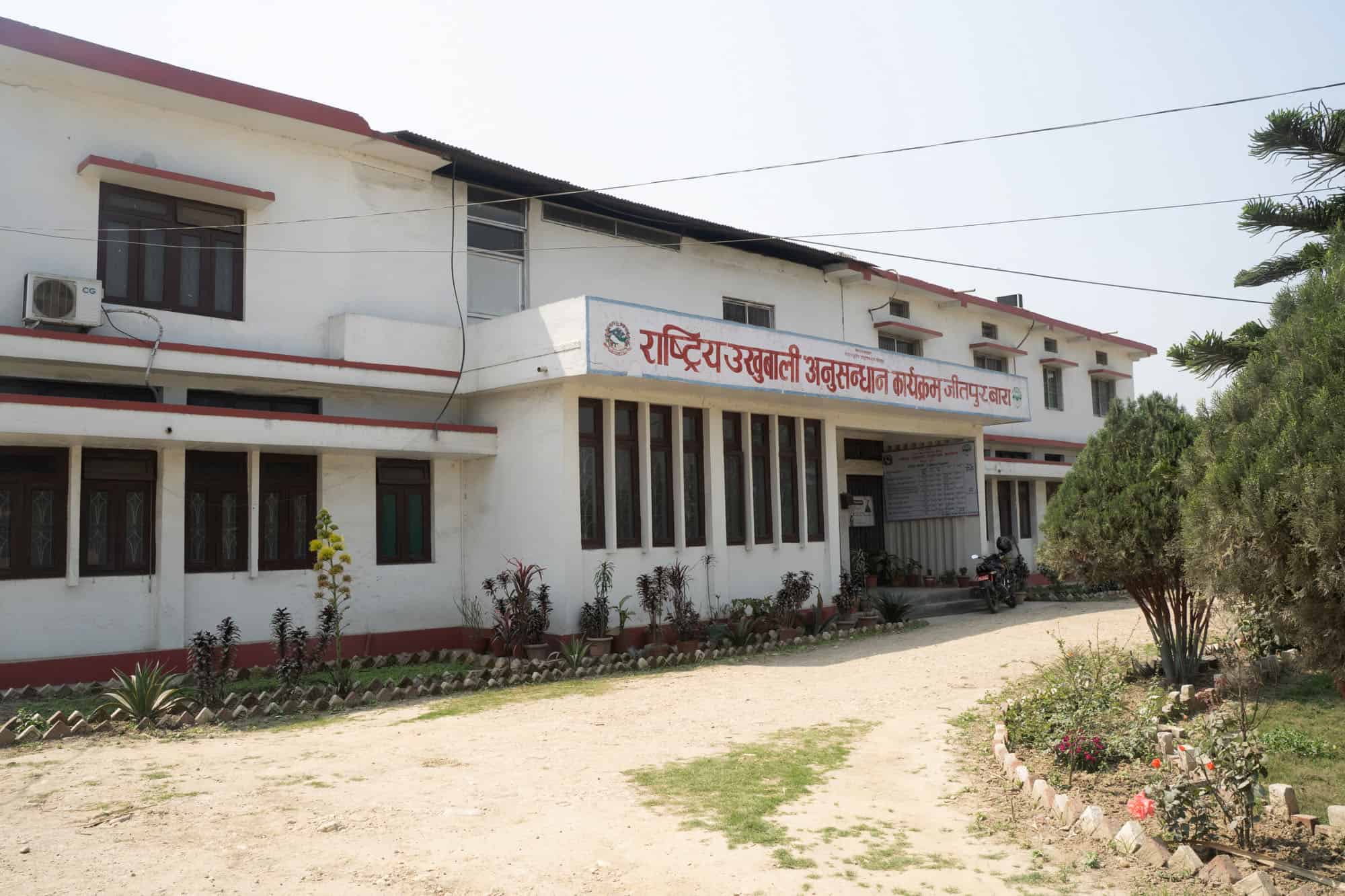
National Sugarcane Crop Research Program, Jitpur, Bara.
Although the program has collected details of 130 varieties of sugarcane from all over the country, it has been unable to recommend improved varieties of seeds. The government started the National Sugarcane Crop Research Program in 1970 to increase sugarcane production. But the program has so far only approved seven varieties of seeds for commercial cultivation.
The approved sugarcane varieties have been named from Jitpur-1 to Jitpur-7. Dilraj Yadav, head of the program, said, “We should have done a lot of research, but we are unable to do it due to lack of resources.”
Although the farmers federation has been demanding quality fertilisers, pesticides and productive seeds, the government has been ignoring such calls, says federation president Kapil Muni Mainali.
“We are compelled to grow the same variety the Indian farmers grow,” says Mainali. In the fiscal year 2017/18, ‘variety 150’ caused problems.”
Dilraj Yadav, head of the sugarcane program, said, “We are doing well in researching crops like paddy and wheat, but sugarcane gets the lowest priority.”
According to Yadav, the office has provisions for 26 employees, but only 13 are working. Yadav said that the work couldn’t be done as the annual budget of Rs 20 million had to cover administrative expenses as well as research.
According to the Ministry of Agriculture, sugarcane was cultivated in 68,565 hectares of land across the country in 2019. The seeds produced by the sugarcane crop research program are only enough for seven hectares. Farmers allege that the program is a sham as it can only produce seeds enough for 0 .10 percent of the total land under sugarcane cultivation.
Declining sugarcane cultivation
Sugarcane cultivation in the country is declining due to the hassles faced by the farmers. According to the Ministry of Agriculture and Livestock Development, in the fiscal year 2019/20, sugarcane was cultivated in 68,565 hectares of land across the country and the production was 3.4176 million metric tons. A year before, the production was 3.557 million 934 metric tons in 71,625 hectares of land. In the previous year, 3.2 million metric tons of sugarcane was produced from 78,609 hectares of land.
Mainali, president of the Federation of Sugarcane Growers, says that the government hasn’t taken action to stop the decline in sugarcane cultivation. He says, “The number of sugarcane farmers is declining. Youths don’t want to engage in farming, if the government doesn’t pay attention now, all farmers and industries will collapse.”
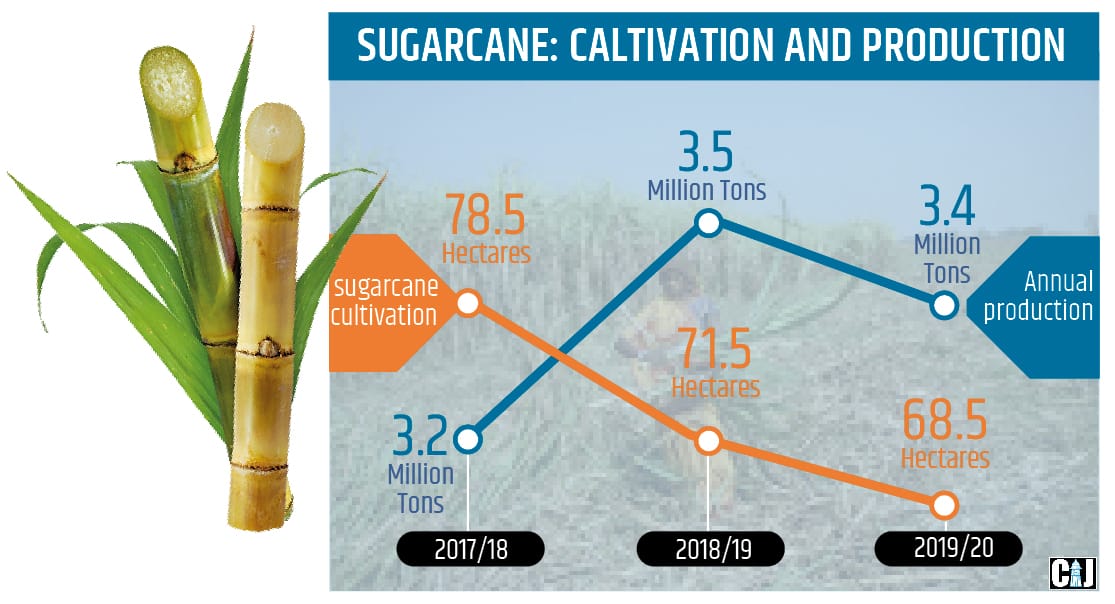
According to the customs department, sugarcane is being imported from India in small quantities. In FY 2019/20, 20,323 kg of sugarcane was imported from India while the next year, only 2,000 kg was imported. Statistics for the current year are not available.
However, residents of the border areas say that businesses import sugarcane from India by evading customs. Sugar mills say that they have to order sugarcane from India due to low production in Nepal.
Former Finance Secretary Rameshwar Khanal says that emphasis should be laid on research for the expansion of sugarcane cultivation. “Sugarcane planted on the basis of speculation does not produce a yield of 9 percent per quintal. How are we to cultivate sugarcane?”
Ram Swarth Ray Yadav, chairman of Sugarcane Farmers’ Struggle Committee, says that Nepali farmers choose sugarcane seeds according to the advice and availability of the sugar industry and other farmers. “The government doesn’t care,” he says.
Rajendra Mishra, chief of the agribusiness and promotion division under the Ministry of Agriculture and Livestock Development, says that the yield of sugarcane (sugar production from a quintal of sugarcane) has been reduced due to lack of irrigation and improved varieties. According to the Ministry of Agriculture, the average yield rate of Nepali sugarcane is only 8.5 percent. In India, the number goes up to 10 to 11 percent.
Growing demand
Although the number of registered sugar mills in Nepal has reached 31, only eight were in operation last year.
Urmila KC, Deputy Secretary at the Ministry of Industry, Commerce and Supplies, says , “The annual demand for sugar in Nepal is 280,000 metric tons. However , last year only 74,000 metric tons were produced, while the capacity of the existing industry is 180,000 metric tons. ” Sugar must be imported to meet the demand of the domestic market.
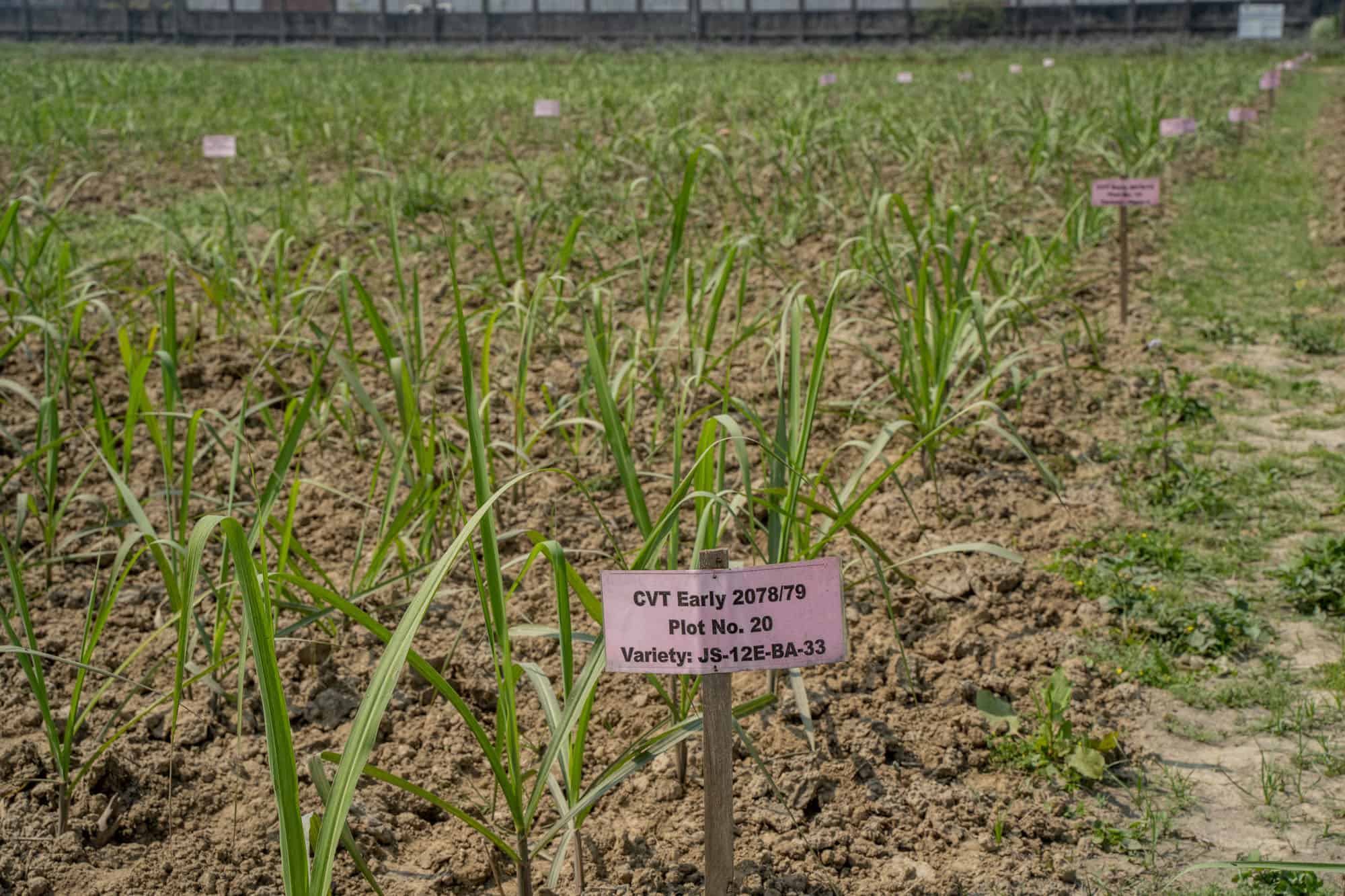
Of the imported sugar, 60 percent is used for domestic purposes and the remaining 40 percent for industrial purposes.
Gyan Prasad Bhattarai, a former member of the Sugar Industries Association, says, “On the one hand, there is no quality sugarcane and on the other hand, this sector is not a priority of the government. So production is declining. ”
The customs department doesn’t keep records of sugar imports only, it combines the data with molasses.
Harihar Poudel, chief officer of the Birgunj customs office, said , ” Sugar imports are high due to industry . About 40 percent of the imported sugar is for industrial purposes.” Although the remaining 60 percent of consumers are considered for food purposes, there is no reliable data on how much sugar is consumed in Nepal.
The price of sugar is increasing every year. Farmers like Siyaram Yadav, who have been cultivating sugarcane for ages, have been growing less sugarcane.
Anup Chaudhary, president of the Kapilvastu Farmers’ Association, says, “Some have reduced their sugarcane cultivation, some have given up.” He said that young people have migrated abroad as it is difficult for them to make a living from farming.
Farmers in remote villages have to come to Kathmandu to protest to demand money for their sugarcane. Ram Swarth Rai, chairman of the Sugarcane Farmers’ Struggle Committee, says, “We are planning to visit Kathmandu again and demand the remaining payment from the mills.”



